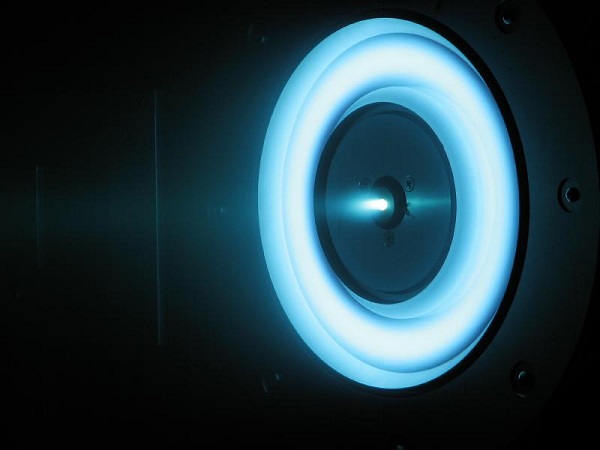Do you lie awake at night worrying about the possibility of an asteroid flying into Earth and ruining your day – or worse? Fret not. One way or another, solar power aims to save us.
Maybe it will be DE-STAR, the concept we explored recently in which a solar-powered laser-beam system would vaporize meteors and asteroids.

Or maybe a new, advanced form of solar-electric propulsion – put to use to capture a small near-Earth asteroid and bring it back to orbit in the Earth-moon system – will provide the new understanding of asteroids that we need to defend ourselves from them.
This latter idea, wild as it sounds, is one that NASA is working on, and a recent “Image of the Day” on the space agency’s site – brought to our attention by Mashable – provides a striking look at the possibilities (but, unfortunately, scant detail on the technology).
It looks like an artist’s illustration, but according to NASA it’s an actual image “taken through a porthole in a vacuum chamber at JPL where the ion engine is being tested.”
Ion propulsion with the aid of solar actually isn’t new. The Dawn mission, launched in 2007, is already using solar power to do xenon ion propulsion on its travels to Vesta (which it arrived at in 2011 and left in 2012) and Ceres (which is should reach in 2015). In ion propulsion, beams of electrically charged atoms propel the aircraft. The propellant here is xenon, and solar panels provide the charging power. According to NASA:
The Dawn spacecraft uses ion propulsion to get the additional velocity needed to reach Vesta once it leaves the Delta rocket. It also uses ion propulsion to spiral to lower altitudes on Vesta, to leave Vesta and cruise to Ceres and to spiral to a low altitude orbit at Ceres. Ion propulsion makes efficient use of the onboard fuel by accelerating it to a velocity ten times that of chemical rockets…. The ion thruster is powered by large solar panels. The power ionizes the fuel (Xenon) and then accelerates it with an electric field between two grids. Electrons are injected into the beam after acceleration to maintain a neutral plasma.
NASA chief Charles Bolden was at the Jet Propulsion Laboratory in Pasadena, Calif., last week to look over a new prototype ion thruster that would make the robotic grab mission, according to the Associated Press. Bolden said he was pleased with progress on the project that would snare an asteroid, haul it close to Earth where we could get to know it a bit – see what makes it tick – and then design and test systems for deflecting any of its brethren from slamming us all to oblivion.
As Don Yeomans, head of NASA’s Near Earth Object Program at JPL, told the AP: “Anytime that you can get up close to an asteroid and understand its composition and its characteristics … that’s getting to know the enemy.”